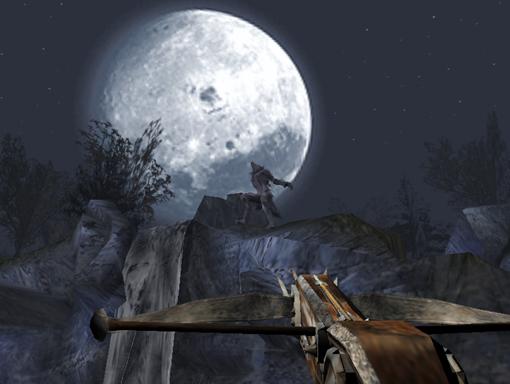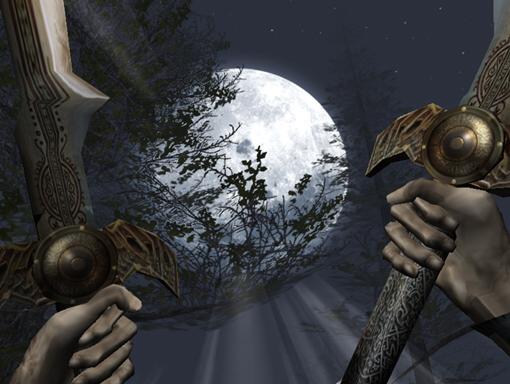Dreadnoughts is a canceled cooperative multiplayer First-Person Shooter developed by Xenopi Studios from 2000 to 2002, for the PC and potentially Xbox platforms.
The game was revealed in February 2001 on the official website of Xenopi as a game mainly designed for cooperation of players in multiplayer mode:
“Dreadnoughts is an exciting new first-person action game set in the distant future which pits different competitive factions against each other in a battle to determine dominance over whole planets. Designed from the start to focus on cooperative multiplayer gaming, Dreadnoughts is the first game to seamlessly combine the adrenaline and excitement of first-person shooters with the strategy and tactical finesse of capital ship combat.
Instead of trying to duke it out single-handedly with every other player, the player is a crew member of a gigantic fighting ship known as a Dreadnought. Crew members must work together to survive battles with competing Dreadnoughts. These battles can have simple objectives such as “Destroy the enemy Dreadnought” or complex and detailed missions with multi-task objectives such as “Gauntlet Run”, “Domination”, and “Capture & Escape”.
Because Dreadnoughts gives the player a choice of character roles, players can play the way they want. Take to the fields as a skilled combat warrior, or build up defenses and repair damage as an engineer. Wreak havoc on the opposing team as an assassin or lay waste to enemy fortifications with the incredible firepower of the Siege Warrior. Play as a scout and use your speed and agility to recon the enemy while the sniper picks off guards from afar.
If you’re more the strategist, then take your place at the Command Bridge and enjoy the awesome firepower of a fully armed Dreadnought at your command! These “Flying Fortresses” are armed with heavy cannons, anti-grav drives, ion shields, and the ability to take enormous punishment. All of this action takes place both indoors and outdoors in a world with unending terrain and huge complex interiors.”
On july of the same year, Homelan Fed managed to get an interview with three Xenopi’s developers:
HF: What games influenced the development of the game design and why?
D. S. – “Obviously, the major first person shooters out there like Quake and Unreal Tournament influence us, along with the team based games like Tribes, Team Fortress, and Counter Strike. Along with those influences, the ship concept part is based somewhat on that old Genesis game Herzog Zwei. In that game, you had powerful ships that functioned as your main base of operations while your units tried to take over smaller bases to gain more power. We thought that dynamic could be adapted well to a team based first person shooter. I also liked the idea of two ships getting in firefights with people manning turrets against an enemy ship and trying to board it, and I’m sure I got inspiration for that from Skies of Arcadia.”
HF: What is the story premise behind Dreadnoughts?
J.B. – “It’s very sci-fi…it takes place in a galaxy that had previously been unexplored by our three warring species (the human “Terrans”, the insectoid aliens called “V’reen” and the self-replicating machines known simply as “The Droids”).
The backstory is this…numerous unknown signals were being picked up as the war grew closer to this uncharted galaxy. It turns out that the signals eminated from numerous planets within this galaxy. Further exploration uncovered the remains of an ancient alien civilization that had found a way to draw energy from the surrounding planets through a large number of, what are now referred to as, “outposts” that seem to be this alien civilization’s equivalent of oil drilling platforms or solar farms. So now, a few years after the discovery of this civilization and the power contained within these outposts, the different species have begun to tap into this new power and have derived technologies and weaponry that use this seemingly inexhaustable resource. These numerous outposts and the power they represent are the key to victory for the different species. Whoever can establish control over this galaxy will hold a power without equal and will be able to ensure their victory.
The plan now is to take control of the galaxy planet by planet with your team and Dreadnought at your disposal. Although the looming question is…what happened to this alien civilization? How could a species that held what appears to be unequaled power disappear? What caused their demise? Or Who?”
HF: How does the class-based design for the game work?
J.B. – “As mentioned, the different classes of characters provide roles for the team. All have completely unique abilities and will have class-specific weapons available to them. However, our goal is to make each class unique beyond just the weapons they can carry. Currently, we have 7 classes which include a Commander, Combat Warrior, Siege Warrior, Sniper, Assassin, Ranger, and Technician. The Commander’s main role is leading the team and piloting the Dreadnought. This role is vastly different than the others. The Commander is much less combat oriented and will be directing the assault from the Dreadnought, managing the systems, directing energy to the 3 major systems (engine speed, shields, and ship weapons). Essentially, you are “Kirk” on the bridge directing the action when you play as the Commander.
The Technician is also very unique. He’s basically designed as a defensive player who will be assisting the Commander in defending the Dreadnought, repairing and building turrets, repairing generators, and assisting the Commander in managing the systems. But the Tech can also mix it up on the battlefield with his weaponry and ability to construct anti-infantry turrets.
The other classes are more similar in that they are combat oriented, but their abilites and strengths still differ greatly. For instance, the Assassin can cloak to “near-invisible’ (a la Predator) and has a melee attack that is an instant kill…and the Siege Warrior is the heaviest armed and armored class, but will be slower and have less of a vertical range with his jetpack.”
HF: How do the dreadnoughts themselves figure into the game?
D. S. – “Your Dreadnought is not only your base, but it’s the most potent weapon in your arsenal. On one hand, you have to protect it and keep the enemy from boarding it and trashing the place, but on the other hand it’s very useful for taking over outposts or for attacking weakened enemy Dreadnoughts. It’s all about figuring out the right time to switch from defending your Dreadnought to attacking with it. Anyway, the whole score of the game is based on how many times you’ve destroyed the enemy team’s Dreadnought before time runs out. So if they destroy your Dreadnought, they get a point, and vice versa.”
In the following months, a FAQ page was also published on the website in order to learn more about the game:
“In the standard game, the players of the game are split into two or more teams. Each team has a large capital ship, or Dreadnought, as their base. Unlike other team FPS games, the bases in this game can be piloted and moved. The goal of each team is to destroy the other Dreadnoughts while protecting their own Dreadnought from destruction. Each time a team destroys a Dreadnought, the team earns a victory point. After a preset time limit, the team with the most victory points wins. Scattered across the game world are several outposts. Each outpost can be captured or recaptured to produce energy for a player’s team. Captured outposts can also be outfitted to attack opposing players or Dreadnoughts that pass by. While the Dreadnought ship is a team’s base and has to be protected, it also possesses great offensive strength. When it is used effectively to help attack enemy outposts or even weakened opposing Dreadnoughts, it can often turn the tide of the game. Players have several classes to choose from and can switch between classes inside Dreadnoughts and outposts during the course of the game. Each class has specific strengths and weaknesses.
The characters will all have jetpacks that allow them to fly for a period of time, similar to Tribes. Using the jetpack will drain energy. Not using it will allow the jetpack to “recharge”. We are currently planning on allowing the lighter classes a broader range than the slower, heavier units.
There is a large holographic map of the game world on the bridge of the ship. The captain uses this map as an interface to define the path he or she wants the ship take. So the piloting interface of the ship is handled more like a Real Time Strategy game. This method is easy and quick, and it will allow the captain to spend his or her time directing the team and not just piloting the ship.
As indicated by their name, Dreadnoughts are heavily armed and protected battleships. There are several different strategies a team can use to destroy another team’s Dreadnought. The simplest way is a direct “Dreadnought-vs.-Dreadnought” battle. While this is the easiest to initiate, it’s also probably the least advantageous. Since Dreadnoughts are pretty much equally armed/armored (at least, at the start of a game), the chances of winning a simple “head-to-head” battle are about 50-50. Another way to destroy the opposing team’s Dreadnought is to send Raiding (boarding) parties over to the other Dreadnought in order to destroy critical systems and THEN bring in your Dreadnought to finish off the crippled enemy Dreadnought. Yet another strategy is to increase your Dreadnought’s energy reserves (by taking over energy-producing ground outposts) thereby increasing your Dreadnought’s firepower and making your Dreadnought “stronger” than the enemy Dreadnought. Players should note that the Engineering station allows the team to adjust energy apportioning for the Dreadnought – you can direct more power to shields for greater protection, or more power to weapons for greater firepower, or more power to engines for greater speed. It’s a system which really is designed to reward strategists as well as tacticians.
Each ship has a baseline energy output that keeps all systems functioning normally. Captured outposts generate energy and beam it directly to your Dreadnought. Acquiring extra energy can increase each system’s output. The team that has captured more energy outposts earlier in the game will have an obvious advantage, but these possessions may change many times during the course of a battle.
Teams can also use captured outposts as a place to repair and reload. They can add automated turrets to fortify the outpost. These turrets can be used to attack passersby and wear down the shields of Dreadnoughts if they fly too close.
There is a standard base soldier class, along with more specialized classes like the sniper, the technician, the ranger, the assassin, and the Siege Warrior (a heavily armed and armored fighter). There is the important Commander class as well. This player is responsible for coordinating attacks and defenses as well as piloting the ship. Of course, the Commander can still personally mix it up with the enemy in hand-to-hand combat if he or she feels the need to.”
Unfortunately, Xenopi became more and more silent afterwards, and it was not until July 2003 that they announced the cancellation of Dreadnoughts, apparently already stopped for a while. We can assume that the project had not interested any potential publisher and that Xenopi was forced to fall back on more economically viable projects, before disappearing completely. Their only game was Pandamonium, a web game released in 2003.
Images:


